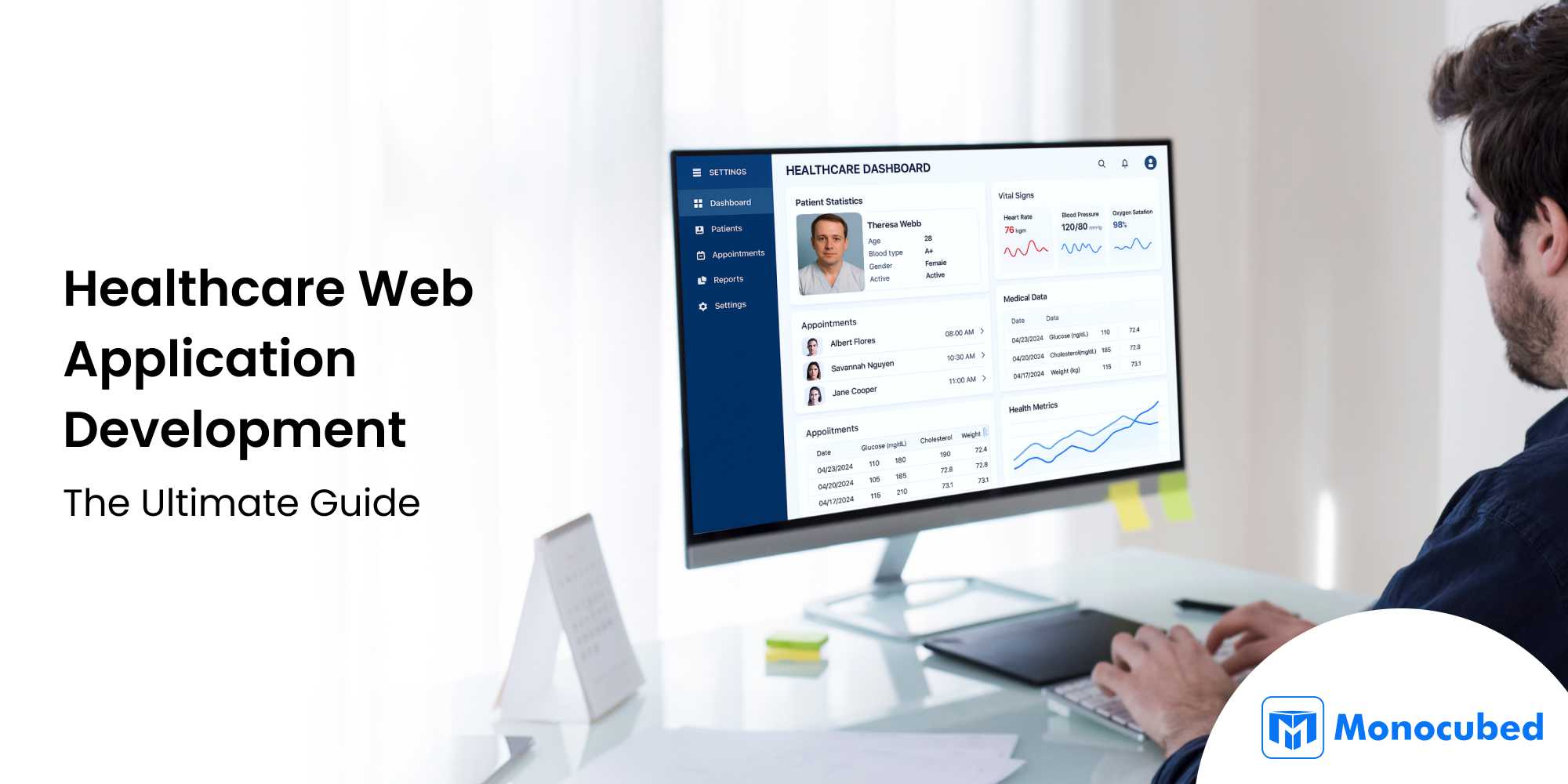Are you still struggling with legacy systems, disconnected records, or slow, frustrating patient portals? And healthcare organizations that fail to adapt risk falling behind their competitors, who focus on streamlining consultations, medication management, symptom tracking, and access to medical information.
At Monocubed, we’ve partnered with healthcare founders, clinical teams, and healthtech startups to build web platforms that solve these exact challenges. This web agency offers healthcare web application development services that handle everything from automating patient intake to integrating with EHRs to ensuring HIPAA compliance.
In this guide, you will learn how to successfully develop a centralized healthcare and medical application for your organization.
Table of Contents
- What is Healthcare Web Application Development?
- Why Healthcare Web Apps Matter in 2025: Stats and Latest Trends
- 5 Common Types of Medical and Healthcare Web Applications
- How to Build a Healthcare Web App: A 7-Step Process
- How AI and NLP Are Enhancing Healthcare Web Applications
- How Much Does It Cost to Develop a Healthcare App?
- Work With Monocubed – A Healthcare Web Development Company
- Frequently Asked Questions
- How to plan and build healthcare web applications that work
- What features matter for medical web solutions
- Real costs and timelines you can expect
- How to handle HIPAA compliance without headaches
- Technology choices that make sense for healthcare
Let’s move forward to get deep insights about everything you want to know.
What is Healthcare Web Application Development?
Healthcare web application development is the process of creating a web-based application that healthcare providers, administrative staff, doctors, and patients can access through web browsers. It enables users to connect, manage data, and access services online from any device, such as tablets, mobile phones, and desktops.
For healthcare organizations, it enhances patient engagement, improves workflow efficiency, and potentially reduces costs by optimizing processes such as appointment scheduling and data management.
The features of healthcare web development
| Features | Functionality | Impact On Performance |
|---|---|---|
| Patient Portal | Central access to records, test results, appointments, prescriptions, and bills. | Empowers patients to manage their care and reduces support calls. |
| Secure Messaging | Encrypted communication with doctors and care teams, including text, voice, and image sharing. | Improves communication and convenience while maintaining HIPAA compliance. |
| Appointment and Schedule Consultation | Bookings, reminders, waitlists, and calendar views for providers and patients. | Reduces no-shows and streamlines scheduling for all users. |
| Telehealth Visits | Virtual consultations via secure video and chat tools. | Expands access to care, especially for remote or high-risk patients. |
| EHR Integration | Real-time access to patient history, medications, lab reports, and clinical notes. | Supports better diagnosis and continuity of care. |
| Advanced Search & Filters | Find providers or services by specialty, symptoms, availability, language, or gender. | Makes it easier for users to find the right care quickly. |
| Accessibility Compliance | Support for screen readers, keyboard navigation, high contrast, and readable fonts. | Ensures inclusivity and app meets ADA/WCAG standards. |
Why Healthcare Web Apps Matter in 2025: Stats and Latest Trends
Healthcare is an evolving industry with a vast demand for virtual healthcare advice. This has led to significant growth in EHR software development and a move towards convenience.
Here are the quick figures to prove it:
- According to the report from GlobeNewswire, the healthcare IT software market reached USD 166.8 billion in 2024 and is forecast to nearly double to USD 389 billion by 2030, growing at a 15.46% CAGR
- According to Grand View Research, in North America, over 80% of hospitals have adopted electronic health record (EHR) systems and launched patient portals and clinical apps to enhance patient engagement.
- According to Becker’s Health IT, as patients increasingly favor digital experiences, over 90% of healthcare organizations have launched one-stop digital health platforms.
The above statistics underscore the importance of investing in secure and scalable healthcare web app development. As organizations evaluate their development options, many are exploring how to outsource web development to specialized teams with healthcare expertise, thereby ensuring both compliance and technical excellence.
5 Common Types of Medical and Healthcare Web Applications
Different healthcare organizations or medical enterprises have different goals. Some want better patient engagement, others need operational efficiency or care coordination.
Here are the main types of healthcare web applications, their functions, and the groups they’re best suited for.
-
Electronic Health Records (EHR) systems
EHR systems store and manage patient medical information digitally, enabling doctors to access stored patient medical histories, track medications, check lab results, and review previous reports. By leveraging the insights provided by this type of medical web application, healthcare providers and doctors can make more informed treatment decisions.
Best for: Organizations seeking improved care coordination, accurate medical records, and seamless sharing of patient information with doctors.
-
Telemedicine and virtual care platforms
Telemedicine and virtual medical care web platforms allow doctors and patients to meet virtually rather than in person. It includes:
- Video calls between doctors and patients
- Screen sharing for reviewing test results
- Chat messaging for quick questions
- Integration with medical devices for remote monitoring
Best for: This type of medical web application is ideal for doctors practicing in rural or remote areas, as well as medical specialists who serve patients from multiple locations. Virtual platforms are also ideal for follow-up care that doesn’t require physical exams, such as mental health and counseling.
Real-world example:Problem: A client of Monocubed, MedCall Advisors, sought a custom telehealth platform that enables phone and video-based consultations for both general and occupational health.
Solution: The team of healthcare web developers addressed the problem and built a Medicare web application using Laravel, MySQL, and Redis, incorporating features such as doctor and patient management, chat groups, data logs, work group settings, and more.
Outcome: Following its launch, the web app enhanced physician access, reduced operational costs by an average of $400 per incident, and enabled over 78% of doctor visits to be conducted online.
-
Patient portal web applications
Patient portals provide individuals with direct access to their health information and services. This access allows users to view medical records and test results, schedule and reschedule appointments, request prescription refills, or message a healthcare team in the event of an emergency.
Best for: This self-service medical web app reduces phone calls for routine requests, boosts patient satisfaction scores, and enhances workflow efficiency.
-
Medical practice management systems
This type of healthcare web app enables administrative staff and other healthcare management personnel to manage the business aspects of running a medical practice.
Best for: This management system is best for scheduling and payroll management, insurance verification, claims processing, or appointment scheduling across multiple providers.
-
Health communities and support forums
This type of healthcare web app creates online spaces where patients with similar medical conditions, caregivers, and healthcare providers can connect, share experiences, and provide mutual support.
Additionally, such platforms help people dealing with health challenges to find community, share practical advice, and receive emotional support from others who understand their situation.
Best for: This community platform is best for organizations serving patients with chronic conditions like diabetes or cancer, mental health practices that want to extend support beyond appointments.
Build the Right Healthcare Web App for Your Needs
Not sure which medical web solution fits your organization? Our experts help you choose the right type based on your specific goals and operational workflows.
How to Build a Healthcare Web App: A 7-Step Process
Building healthcare web applications requires a structured approach that strikes a balance between innovation and regulatory compliance.
Understanding the complete web development life cycle is crucial for healthcare projects, as they involve additional phases for compliance verification and security testing that standard web applications don’t require.
Here’s our step-by-step healthcare web application development process, followed by a team of developers:
-
Step 1: Figure out what problems your app will solve
Don’t rush yourself to start building the healthcare web app until you know precisely what you’re building and why it’s being built. This means talking to real people who will use your healthcare web application. Here are a few things to do:
- Interview doctors, nurses, and administrative staff to gather insights into their daily frustrations.
- Survey patients about what they find challenging to do with current systems.
- Watch how people currently handle tasks you want to automate.
- Examine competitor platforms to identify what works and what doesn’t.
- Check HIPAA and other compliance requirements early in the process.
The key is documenting everything you learn. Review the items listed in the table below to document.
What to Document Examples User Types Patients, doctors, nurses, admin staff Core Features Appointment booking, medical records, messaging System Integrations EHR, billing systems, pharmacy software Compliance Needs HIPAA, state regulations, audit requirements -
Step 2: Design simple user flows
Healthcare applications need to work for everyone, from tech-savvy doctors to elderly patients who rarely use computers. The user experience directly affects whether people use your application.
- For patients, focus on making it easy to sign up, book appointments, view test results, and message their healthcare providers. Keep the interface clean and use large, readable fonts.
- For healthcare providers, prioritize quick patient search, simple appointment management, and easy charting and reporting.
Pro Tip: Use soft colors that don’t strain eyes, keep layouts uncluttered, and ensure everything works seamlessly on phones and tablets. Remember that in healthcare settings, people are often stressed or distracted.
Understanding the importance of user experience in web development becomes even more critical in healthcare, where poor UX can directly impact patient care and provider efficiency.
-
Step 3: Choose the technology stack that scales with time
Your technology choices significantly impact how quickly your app runs, the number of users it can support, and the level of security for patient data. Select the latest web technologies tailored to your specific healthcare needs for secure, high-performance healthcare web development.
Technology Layer Options Frontend Technologies React.js, Angular, Vue.js, HTML, CSS Backend Technologies Node.js (JavaScript), Python, PHP, Ruby on Rails, Django Database PostgreSQL, MongoDB, SQL Server Testing Frameworks Jest, Jasmine, Mocha Choosing the right tech stack means your healthcare website runs smoothly on a server with top performance and speed and offers a highly secure, seamless user experience to users.
When selecting your backend technology, consider the specific needs of your healthcare application. For instance, Python vs JavaScript comparison shows that Python excels in data processing and AI integration – crucial for healthcare analytics – while JavaScript offers rapid development cycles. Similarly, PHP vs Node.js analysis reveals that PHP provides mature healthcare frameworks, while Node.js excels in real-time applications like telemedicine platforms.
For frontend frameworks, Angular vs React comparison can help you decide between Angular’s enterprise-ready structure (ideal for large hospital systems) and React’s flexibility (perfect for patient-facing applications). The Vue vs Angular debate also highlights Vue’s learning curve advantages for smaller healthcare teams.
-
Step 4: Build the core features first, then iterate
Start with features that solve your biggest problems. This approach leads you to launch your healthcare and medicate website with faster time-to-market and enables you to fill the gap quickly.
Divide the medical website design and app development into 2 phases:
Phase 1 (MVP): Begin with core functionality that directly impacts daily operations.
- User registration and role-based login
- Patient data entry and retrieval
- Basic appointment management
- Secure messaging and EHR integration
Phase 2 (Enhancements): Get feedback and make adjustments quickly, focusing on one feature at a time.
- Health analytics dashboards
- Telemedicine module
- ePrescription and billing integrations
- Offline mode and mobile optimization
It enables the development of a medical web app that scales with evolving market demands and meets user expectations as well.
-
Step 5: Build security into everything from day one
Healthcare applications require protection at every level, and retrofitting security can be expensive and risky.
Here are the key security practices to follow:
- Encrypt all data at rest and in transit using strong encryption protocols.
- Enforce multi-factor authentication (MFA) for all users to prevent unauthorized access.
- Implement role-based access controls (RBAC) to ensure that only authorized users can access sensitive patient data.
- Maintain comprehensive audit logs of all user activity for accountability and compliance tracking.
- Create secure data backup and disaster recovery procedures to protect against data loss or ransomware attacks.
- Define administrative security policies aligned with HIPAA regulations and conduct regular staff training.
- Conduct periodic security risk assessments and stay informed about evolving threats.
Failure to comply with the Health Insurance Portability and Accountability Act (HIPAA) can result in severe legal penalties, reputational damage, and loss of patient trust. Ensuring both technical and administrative safeguards are in place. For more detailed web application security best practices please read this guide on best practices for securing your web application.
-
Step 6: Test your medical web app’s every component thoroughly
Healthcare applications require more rigorous testing than typical web applications because errors can have a significant impact on patient care and regulatory compliance.
Conduct functional testing to ensure all features work as designed. Here are what you need to do:
- Run security testing to find vulnerabilities before hackers do.
- Perform performance testing to ensure the app works under heavy use during busy clinic hours.
- Test on mobile devices and different browsers to verify compatibility.
Ensure that user workflows are seamless from start to finish, without confusion. Include compliance testing to confirm HIPAA and regulatory requirements are met.
-
Step 7: Launch carefully and provide ongoing support
Start small with a pilot group of 10-20 users who can give detailed feedback. Monitor usage patterns and resolve issues promptly before they impact your broader audience. Gather feedback and make improvements based on real user experiences. Roll out to larger groups only after everything works smoothly.
After launch, focus on ongoing maintenance and improvement. Including:
- Conduct regular compliance checks and updates, monitor performance, and apply security patches promptly.
- Offer 24/7 technical support for critical issues and maintain comprehensive user training documentation.
- Plan for ongoing maintenance, updates, and improvements based on user feedback and changing regulations.
- Keep the budget for annual maintenance costs that typically run 15-25% of initial development costs.
Once your healthcare web application has progressed through these development stages, it’s time to validate, launch, and continually improve based on real-world usage. But the journey doesn’t end at deployment. Your app’s long-term scalability and success depend on ongoing support, security updates, and performance optimization.
Launch a HIPAA-Compliant Healthcare App
From idea to compliant healthcare platform, we guide you through the complete web app development lifecycle and deliver a scalable solution built for patient trust and data protection.
How AI and NLP Are Enhancing Healthcare Web Applications
From automated patient onboarding and triage chatbots to intelligent voice-to-text transcription for doctors, AI technologies are streamlining healthcare delivery.
For example, chatbots and virtual assistants built using NLP allow patients to:
- Ask health-related questions 24/7
- Get symptom suggestions before appointments
- Schedule follow-ups or receive medication reminders
For healthcare providers, AI tools automatically generate chart notes, summarize patient history, and identify crucial risk factors using predictive analytics. Integrating these AI-driven features can improve clinical efficiency, reduce cognitive load, and enhance overall patient engagement.
How Much Does It Cost to Develop a Healthcare App?
The cost of developing a healthcare web app starts at $15,000 or more, depending on complexity, features, and compliance requirements.
Here’s the cost breakdown of medical care web development:
| Type of App | Estimated Cost (USD) |
|---|---|
| Simple Healthcare Website | $15,000 – $25,000 |
| Basic Patient Portal | $25,000 – $50,000 |
| Advanced Patient Portal | $50,000 – $80,000 |
Factors that influence the cost of healthcare app development
- Compliance Requirements: HIPAA, GDPR, and HL7/FHIR integrations add complexity and cost.
- Third-Party Integrations: Syncing with labs, pharmacies, insurance APIs, or wearables increases development time for healthcare web developers.
- Security Architecture: Multi-level data encryption, audit trails, and secure user authentication are must-haves.
- UX for Multiple Users: Designing interfaces for doctors, patients, and admins adds to effort.
- Cloud Infrastructure and DevOps: Hosting, scalability, uptime SLAs, and deployment pipelines all affect total cost.
- Post-launch Support: Ongoing maintenance, security updates, and feature improvements are crucial and recurring.
Considering all these factors helps you estimate the web app development cost and create a budget that aligns with your business goals and current needs.
Can we reduce the costs of healthcare web development?
Yes. Focusing on modular development, open-source components, and MVP-first approaches can significantly reduce upfront costs while still delivering value. Many healthcare startups begin with a core patient portal or telehealth module, then scale over time.
Work With Monocubed – A Healthcare Web Development Company
Healthcare web development doesn’t have to be complex or costly. With the right partner, you can create secure, compliant, and user-friendly solutions that enhance care delivery, streamline operations, and scale with your growth.
At Monocubed, we specialize in providing custom web development services that are tailored to your unique workflows and compliance needs. From patient portals and telemedicine platforms to hospital management systems, our team brings deep industry experience and technical precision to every project.
Why partner with Monocubed?
- Proven track record with HIPAA-compliant platforms
- Expertise in custom workflows for clinics, hospitals, and telehealth startups
- Scalable architecture built for long-term growth
- Seamless collaboration with your in-house teams
“Monocubed built a healthcare web app that reduced phone calls by 50% and the patient satisfaction score went up significantly. They understood our problem and handed out the solution that made our work easier.”
— Dr. Jennifer Walsh, Family Medicine Practice
Take the chance now and choose a reliable web development company that promises quality with minimal expenses.
Let’s Build Your Healthcare Web App—Secure and Compliant
We define a clear, actionable roadmap for your healthcare website and tailor the solution to address your real-world challenges, enabling you to gain a competitive edge in the industry.
Frequently Asked Questions
-
How is healthcare web development different from regular web development?
Healthcare web development requires additional considerations for patient privacy, regulatory compliance, and integration with medical systems. We must adhere to HIPAA regulations, implement robust security measures, and comprehend healthcare workflows. The development process also includes compliance testing and documentation that standard web projects don’t require.
-
How long does it take to build a healthcare web application?
Timeline depends on complexity:
- Simple patient portal: 4-8 months
- Medium platform with EHR integration: 8-15 months
- Complex hospital system: 15-30+ months
Healthcare projects take longer than standard web applications due to compliance requirements, security testing, and integration complexity.
-
What kind of features actually improve patient engagement?
Here are the key features that help you enhance patient engagement and retention:
- Easy appointment booking
- Secure messaging with providers
- Medical history and report access
- Automated reminders
- Personalized dashboards
Build your MVP of your first medical web app project with these features and monitor their behaviour to identify the next important features for scalability and long-term value.
-
Why do HL7 and FHIR standards matter in medical web development?
A critical part of healthcare web application development is ensuring seamless interoperability between various systems, including hospitals, imaging labs, and pharmacies. This is enabled through the adoption of industry standards, such as HL7 (Health Level Seven) and FHIR (Fast Healthcare Interoperability Resources).
-
What is FHIR, and why is it essential for healthcare apps?
FHIR (Fast Healthcare Interoperability Resources) is a standard developed by HL7 to promote easy, secure, and consistent data sharing in healthcare. If your app supports FHIR, it can freely integrate with EHRs, labs, imaging systems, and even third-party wellness apps, improving compatibility and long-term scalability.
-
What are the common mistakes to avoid in healthcare web development?
Some common missteps that slow down or derail healthcare web projects:
- Trying to build every feature in the first release
- Skipping feedback from doctors or patients
- Choosing the wrong technology or team
- Ignoring compliance until it’s too late
- Overlooking update and maintenance planning
Focusing on solving real pain points and building in stages helps you avoid these issues.
 By Yuvrajsinh Vaghela
By Yuvrajsinh Vaghela



